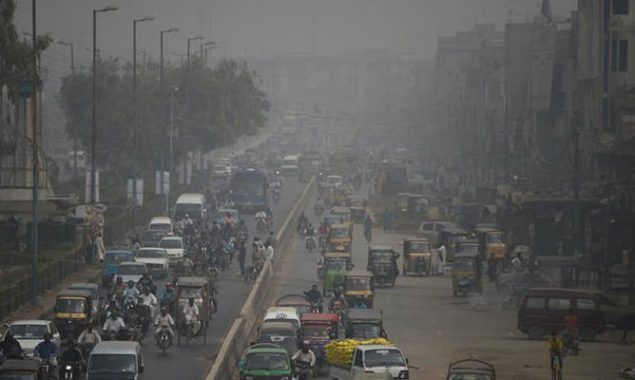Synopsis
Karachi is ranked among the most polluted cities in the world

Photo: File
KARACHI: In recent years Karachi has consistently featured amongst the ‘Unhealthy’, ‘Unhealthy for sensitive groups’ or ‘Moderate’ brackets, but never in the ‘Good’ bracket where air quality is concerned.
The appalling impact of air pollution coupled with other environmental problems lead to at least 20,000 premature deaths in the country each year — 80 per cent of which were in Karachi, a World Bank (WB) report commissioned in 2018 says.
The WB report titled Cleaning Pakistan’s Air: Policy Options to Address the Cost of Outdoor Air Pollution stated that in the case of Karachi nearly 90pc of premature mortality from particulate matter (PM) pollution is among adults who may be losing around 10 years of life due to the PM pollution, consequently resulting in serious social and economic loss.
After the government passed the Pakistan Environmental Protection Agency Act (PEPA) 1997, the Sindh EPA took charge of monitoring air pollution in the province through a network of measurement stations which included a data centre and a central laboratory.
Hazardous air
Pakistan Medical Association (PMA) General Secretary Dr Qaiser Sajjad has warned that Sindh’s capital city will no longer be habitable in terms of air quality in the next decade. “The healthcare system is struggling to identify the deaths that were caused by air pollution. There is no national or provincial data to curb the menace and cardio-respiratory failure is the term commonly stated as the cause of deaths of persons who expire due to the poor air quality situation”, he added.
Key details of patients’ health history including chronic diseases are usually not recorded. The atmosphere is deteriorating and I believe the air quality situation for public health is simply hazardous, he further said.
Dr Sajjad laid emphasis on the usage of face masks for people having nasal allergy, throat issues, sinusitis and other relevant problems. “Even healthy people are at risk of developing respiratory, skin and eye abnormalities”, he highlighted.
Speaking about the sources of air pollutants causing bad air in the provincial capital, he also highlighted that carbon monoxide, lead and sulphur dioxide were the main causes. “Blood lead levels (BLL) especially those in minors are likely to damage the IQ levels, cause memory loss and affect cognition. Residents of industrial areas are most vulnerable to such perils”, the PMA general secretary alerted.
Moreover, he said smoke-emitting vehicles in Karachi add to the environment problems. “The debris from construction sites spreads dust particles that compound the miseries of dwellers. Such irresponsible activities result in silicosis — a long-term lung disease that is caused by large amounts of dust particles in the air. The disease is reportedly common here”, he concluded.
SITE, Korangi vulnerable
Former vice chancellor (VC) Jinnah Sindh Medical University (JSMU) and an ENT specialist Dr Tariq Rafi, while expressing his concerns on the matter said, “I receive many patients suffering from air pollution and underscore that carbon particles in the air are a serious problem particularly in SITE and Korangi industrial areas of Karachi. The air that we breathe contains toxins that leads to health problems. The regional transboundary air pollutants can be controlled with the help of neighbouring countries”, he suggested.
Regarding Sindh’s overall air situation, the former educationist blamed that “fumes from Karachi’s industrial areas and crop residue burning in parts of rural Sindh are equally responsible for the deteriorating air quality.” The general public must continue wearing face masks to avoid breathing polluted air, he warned.
“The environment protection tribunals (ET) under PEPA have the power to issue directions, act to override other laws and also make regulations”, Rafi informed.
According to the WB report, the hazardous lead (Pb) particles in Sindh are sourced from the industries and related workshops as well as the soil. Children are most likely to get affected from the particles. However, the Pb level in children’s blood in Karachi had declined substantially between the 1980s and 2000, owing to abolishment of lead in gasoline.
According to the report, the ETs’ performance was previously hampered by a number of constraints including constant suspension of activities, legal loopholes and lack of clear mechanisms to collect imposed sanctions.
Water pollution, bad air linked
Commenting on the bad air situation, advocate Shahab Usto, who previously worked in a judicial commission to probe Sindh’s deteriorating sanitation conditions, claimed that water pollution and the poor air quality situation in Karachi were interlinked. “The Sindh Environmental Protection Act (SEPA), 2014 does not include heavy penalties on serious flouting of green laws. There are only nominal fines on environmental pollution violations. Moreover, the machinery to protect the air in Sindh had too many compromises and there were issues of departmental corruption”, he said.
He added that the EPA lab was non-functional when he started working with the commission. “During 150 visits to different areas of Karachi and Sindh’s water bodies, the commission learnt how the waste water problem affects the metropolis’ air quality.” The EPA would just send notices to the polluters and no real work was done, the advocate claimed.
“However, after our commission ended in February 2019, the pollution issue in the city practically resumed at the same levels as it did before the commission was formed in the end of 2016. A major problem no one talks about regarding air pollution is that since the provincial capital continues to dump 480 million gallons of untreated waste directly into the sea, the vapourisation of this untreated water seriously affects the air quality”, he further claimed.
While the city continues to struggle with ownership issues between its various stakeholders, the authorities including the Sindh government, Karachi Metropolitan Corporation and cantonments create hurdles of ‘jurisdiction’ that hamper genuine efforts to stop pollution, he concluded.
Uninhabitable city?
Urban planner and CEO Urban Collaborative Farhan Anwar while commenting on the issue stated that over the next five to 10 years, Karachi will no longer be habitable. “The automobiles on the roads of Karachi [are] worsening the situation and there seems [to be] no focus on measures to curb the problems”.
He said that over the past decade, new sources had contributed to the poor air quality in the metropolis. “Unregulated vertical expansion of the city has led to the closing of some ventilation corridors in Karachi, and the burning of rubbish remains an old issue as well”.
He said that although using face masks was not an ideal solution, it should be kept in practice as some means of countering air pollution. He stressed that individual action particularly lifestyle changes could make a difference. “Promotion of non-motorised transport is essential and the city must be redesigned to significantly increase walkability. Cycling to work or study is also the way forward to reduce overall emissions. Smart cities are not possible without the right policies. For Karachi, are we even following green standards?”, questioned Anwar.
Integrated approach
Sindh EPA Deputy Director Mohammad Imran Sabir, who is in-charge Korangi area, has asserted that cooperation of neighbouring countries was the need of the hour as no specific area alone could be blamed for the air quality situation in Karachi and other large cities. He emphasised on dialogue among all concerned and suggested that a coordination mechanism was needed to counter the peril. Conventional methods could not curb pollution and are no longer effective in today’s world.
He claimed that unauthorised burning of crop paddy has not just polluted the air in Karachi but has affected areas of interior Sindh as well.
Commenting on the sources of pollution, he elaborated that traffic was the biggest issue in Karachi. “Our air pollution problem caused by public transit system will be resolved once the Green Line becomes operational,” he said. “Work on the Karachi Circular Railway is also under way and I am hopeful that the city will be able to cope with the rising urbanisation and pollution problem. The air pollution situation over the decade will not worsen as feared. Karachi’s green cover strategies in place since 2017 have increased tree plantation on ground which were once barren and all stakeholders including Sindh government, NGOs and responsible citizens are actively taking part in this”, claimed Mr Sabir.
Karachi’s air quality, despite efforts by various stakeholders, remains consistently poor throughout the year and is among the worst in the country. Achieving the desired results in the metropolis would still require active participation to curb pollution. A strong political commitment by stakeholders at different levels is the need of the hour.
Catch all the Pakistan News, Breaking News Event and Latest News Updates on The BOL News
Download The BOL News App to get the Daily News Update & Follow us on Google News.




